#kushite dynasty
Text
Upon the controversy of netflix Cleopatra’s documentary I cannot believe we are still sleeping on the Kushite dinasty. I like Cleopatra but Piye did not went all the way from Nubia to conquest a war torn Egypt just to be forgotten. How is there not a documentary about how he conquered the city of Memphis intalling his sister Amenerdis and later daughter Shepenupet as Divine Adoratrice of Amon who ruled in his name.
The Black pharaos did not invest on rebuilding Egyptian ancient monuments, styled thelmselves as pharaohs a tried to build pyramides for a Greek Ptolomaic to be remember as a Black Pharaoh. (Not to speak about the Queens Kandake of Meroe who ruled Kush on their own at the same time of Cloepatra family).
25th dinasty I’m so sorry you are so cool
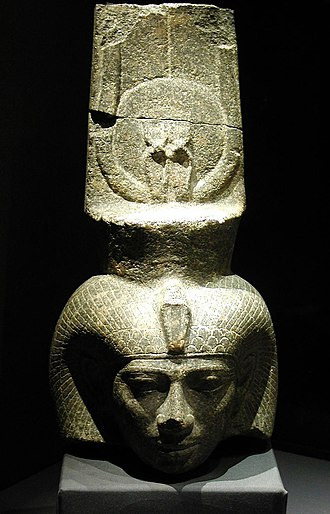
Head of Shepenupet II from Alexandria National Museum, Egypt

Sphinx of Pharaoh Taharqo

Portrait of Tantamani in his tomb in El-Kurru
#ancient egypt#cleopatra netflix#25th egyptian dinasty#kushite dynasty#WE HAVE TO CALM DOWN ABT PTOLOMAIC
32 notes
·
View notes
Text
Samuel Huntington might have a stroke with this phrasing, the more reason to use it:
One of the first good examples of a 'Clash of Civilizations' was the clash between the Egyptianized Kushite Dynasty and the world state of Assyria, where today's Black History Month writing calls its pause. The world of the Ancient World was a much smaller place with powerful kingdoms in localized areas, that exercised very vast power indeed in much smaller areas and were completely unconcerned with things like 'freedom' and 'human rights' when they had the power to flex it, though the writings of the merchants of old Assyria show equally cynically that where they could not there are prototypes of appeals of the weak against the strong.
Assyria, however, invented the concept not just of the grand king of kings, which predated them as far back as Sarru-Urukhin of Agade (in usual Anglicization Sargon of Akkad), but a true world empire that spanned everywhere its armies could reach. It developed the system of provinces, roads and post offices, mass ethnic cleansing to be a 'final solution' to bothersome thorns in the flesh, and other atrocities that would become the standard points of classical to modern empires.
The great Kushite Dynasty was an apex of the previous era, of the Ancient versus the first stirrings of the Classical. In the event the sheer weight of the Assyrian state and the powers it invented and could call upon were too much and for the first of many times the Pharaohs fell before the power of world states that wanted Egypt as a granary and treated it as such.
There is also something very modern and ironic about a clash of civilizations between the first of the true world empires (and yes it was first, Qin would not unify China for another 500 years or so by the time these guys got started on the Empire business) and a Black state standing for an older order. In this case the Pharaohs lost decisively and the Assyrians confirmed the new order that would find its counterparts in central Asia and in East Asia and in Mesoamerica and the Andes and become a global standard elsewhere.
#lightdancer comments on history#black history month#military history#egyptian history#kushite dynasty#assyrian history#clashes of civilization
0 notes
Text
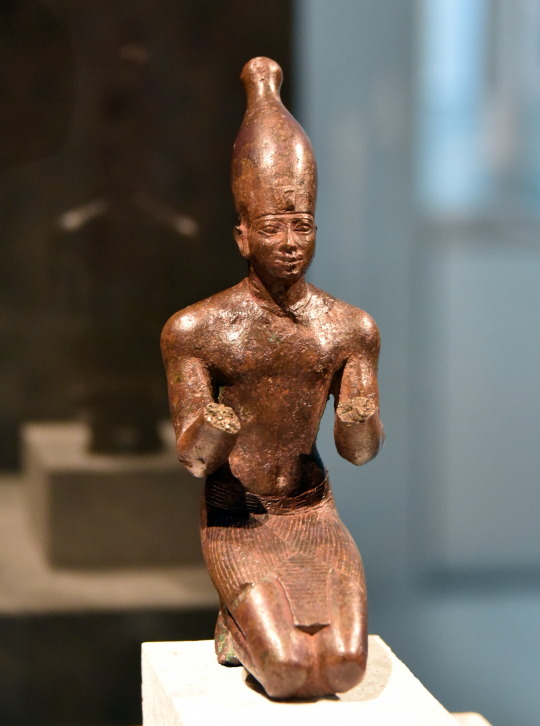
Bronze statuette of a kneeling Kushite king, wearing the white crown of Upper Egypt. Artist unknown; 25th (Nubian/Kushite) Dynasty, Third Intermediate Period. Now in the Neues Museum, Berlin. Photo credit: Osama Shukir Muhammed Amin FRCP/Wikimedia Commons.
#art#art history#ancient art#Egypt#Ancient Egypt#Egyptian art#Ancient Egyptian art#Nubian art#Kushite art#25th Dynasty#Third Intermediate Period#sculpture#portrait sculpture#statuette#metalwork#bronze#bronzework#Neues Museum
143 notes
·
View notes
Text
I literally never give a shit about movies casting non poc characters as poc like who gives a shit. But the new netflix doccuseries about like “powerful women in history” is a fkn joke. If theyre presenting something as a “documentary” and its about history something feels fkn malicious about race changing someone like cleopatra.
Presenting something completely changed to suit the current attitude of the general populace is big big yikes. Rewriting history has always been an agent of cultural erasure and the complete decimation of TONS of things that shouldve been remembered. Rewriting history is just about reaching toward fascist territory.
If you are presenting something that is meant to be somewhat “factual” and you completely change the race of who the person fkn is…? Is that not insane? Where is the line where it becomes not ok? Can people just start claiming that all influential people of history were some kind of POC as if to say “look the atrocities committed weren’t all that bad because they’re a poc.” “They were protecting their race! their people!” by doing these awful things? Like so were the fkn nazis??? This little thing is indicative of such dangerous fallout and misinformation that can spiral down into bullshit real fast and I fkn hate it.
#BIG ASS EYEROLL#its not ‘woke’ to cast a real person from history as POC its genuinely destructive to fkng history#not all… africans are black……….#she ruled an empire of slaves just like everyone before her…..#making her black is not girl power i just HAJFNSKFNWKSJD#Her race really didnt fkn matter in like what she did for her years if ruling or like how she behaved that part doesn’t matter#but to say in our modern world that cleopatra was black has such dangerous implications#You cannot erase history and present it in a way that the modern world would like to see#thats fucking gross#the ptolemaic dynasty was… not….. black#kushite dynasty was black!!! perhaps find a woman from that dynasty and make an episode about her rather than rewrite fkng history#RANT RABT#It needs to be said that I am double indigenous and I am TIREDDDDD of shit like this#My peoples history has been destroyed again and again by this attitude
20 notes
·
View notes
Text

HYKSOS???
If the direct translation of Hyksos is “rulers of a foreign country” then wouldn’t Nefertiti and Akhenaten be considered foreigners to the land? It explains the connection between Abraham and Hammurabi with ease.
Moreover, it flies in the face of more recent theories that all of the dynasties of Egypt we think of were Semitic in origin. I mean, 1750 BCE is almost 1,500 years after a Kushite by the name of Menes unified North and South Egypt and set up the first dynasty.
Or, hear me out. Is it because of the way we lump together groups with the term Semitic that’s the issue. It was created by a linguist who observed the sons of Shem spoke a set of related languages. Unfortunately, the verse in Genesis that ties the sons of Shem together does so by blood. So now, we associate the Semitic language with constructs like race instead of culture.
Somebody with a more extensive grasp on history please jump in and explain this. I’m genuinely perplexed.
17 notes
·
View notes
Text
Isaiah 19-20: An Oracle Against Egypt
he prophet Isaiah announced, there would be another cataclysmic contest between God and the gods of Egypt. Just as in the days of Exodus, God’s judgment of Egypt would be complete. #Isaiah20 #Esarhaddon #Taharqa #KushitePharaoh

View On WordPress
#Assyria#Cush#esarhaddon#isaiah 19#isaiah 19-20#isaiah 20#kush#kushite pharaoh#Plague#plagues#sargon#taharqa#taharqa dynasty
3 notes
·
View notes
Text
Tantamani: Kushite King of Napata & the Last Pharaoh of the Twenty-fifth Dynasty
Tantamani, also known as Tanutamun, was a significant figure in ancient Egyptian history as the last ruler of the Twenty-fifth Dynasty. His reign marked the culmination of Nubian rule over Egypt and the subsequent end of the Kushite pharaohs’ dominance in the region. Tantamani’s story is a compelling narrative of ambition, power, and the struggle for control over a vast and culturally rich…

View On WordPress
#African History#Ancient Egyptians#ancient egyptians history#Egypt history#Kushite King#Last Pharaoh#North African History#Tantamani#Twenty-fifth Dynasty
1 note
·
View note
Text
Taharqa Invades Spain

The young Prince Taharqa of Kush, fated to become king of an empire that spreads from his homeland in Sudanese Nubia all the way down to the Nile Delta, leads an invasion of southern Spain circa 700 BC. This is of course another alternate history scenario, but the inspiration came from a handful of apocryphal accounts from historians such as Strabo and Ahmed ibn Mohammed al-Makhari that report that he ventured to the “pillars of Heracles” (the Gibraltar Strait between Spain and Morocco) and led an expedition into Spain. Archaeological evidence of such Kushite forays remains undiscovered, but considering that the Phoenicians from Lebanon had already established trading posts on the Spanish coast as far afield as modern Cadiz by that time, an army from the Nile Valley making it there is not totally impossible. Who knows, maybe Taharqa and his soldiers here are defending one of the Phoenician settlements from hostile local tribes?
#Taharqa#nubian#kushite#25th dynasty of Egypt#sudanese#african#black men#dark skin#spain#spanish#iberian#ancient#battle#alternate history#digital art#art
0 notes
Text
The Roman Pharaohs of Ancient Egypt
In ancient history the pharaoh was the head of state and ruler of the country. However, he was not just a secular ruler, but a divine being on Earth who acted as an intermediary between the spiritual world and the earthly world. In essence he was a mortal representative of the gods. Interestingly, one did not have to be an Egyptian to be an Egyptian pharaoh. The act of conquering and ruling Egypt qualified one to be a pharaoh. As a result there were many foreign pharaohs throughout Egyptian history including those who were Persian, Nubian, Libyan, Hyksos, Kushite, and Macedonian Greek.
In 30 BC Cleopatra VII became the last ruler of Egypt from the Macedonian Greek Ptolemaic Dynasty. Cleopatra had backed the losing side of a Roman civil war, opposing Octavian and supporting Marc Antony. Octavian won, she was deposed, she committed suicide, and Egypt became a Roman province. When Octavian became Augustus and founded the Roman Empire, the Egyptians also recognized him as the official Pharaoh of Egypt. Afterwards successive Roman emperors were also declared pharaohs, until around the 4th century when Christianity became the dominant religion in Egypt.
Truth be told, most if not all Roman emperors didn't give a damn about being pharaohs. Most emperors never even stepped foot in Egypt and it didn't seem like they took their role as pharaoh very seriously. Regardless Egyptian iconography and art was crafted depicting Roman emperors in Egyptian style wearing Egyptian royal regalia and interacting with Egyptian gods. Some interesting examples are...
Gigachad Pharaoh Augustus

Tiberius

Nero
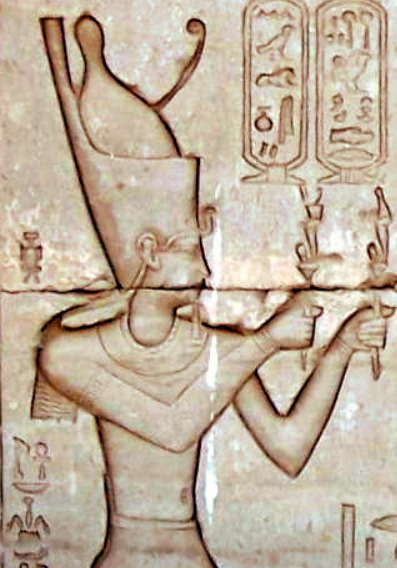
Nero again

Trajan making sacrifices to Hathor
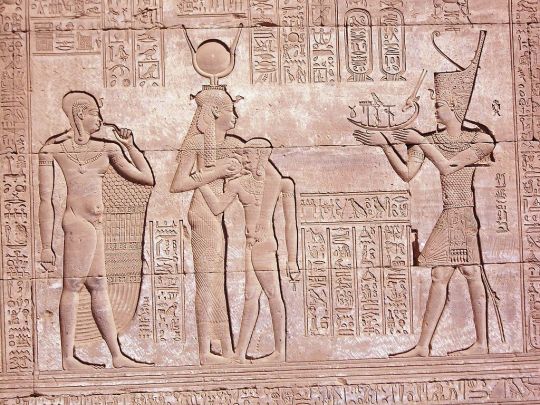
Domitian

Domitian with Horus
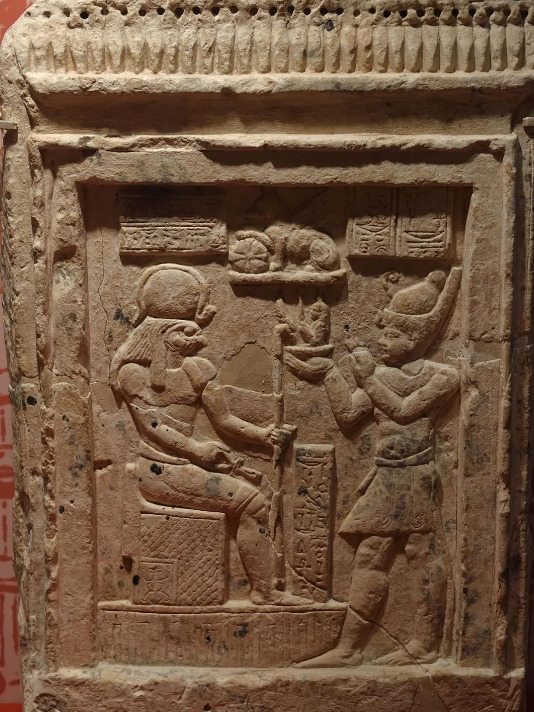
Caracalla
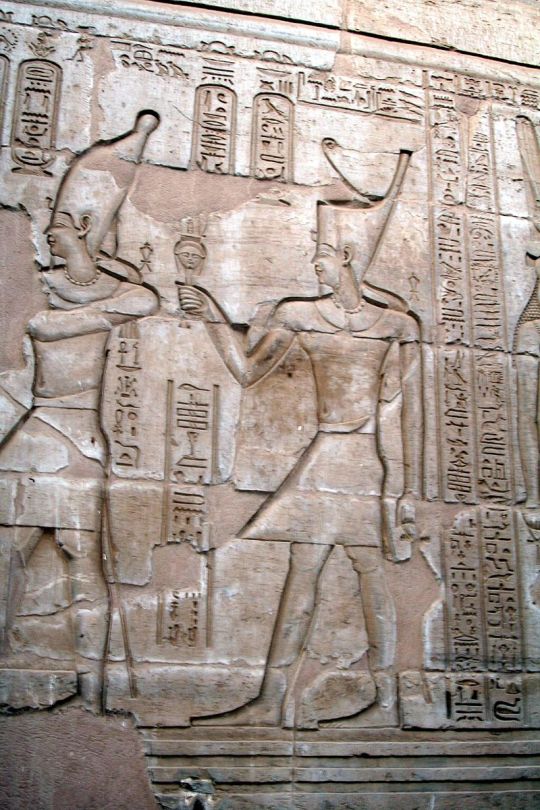
Marcus Aurelius

102 notes
·
View notes
Text
I've been asked to weigh in.
So.
No, Cleopatra wasn't black. She wasn't even African. Her family was Macedonian Greek, and they were infamously the most incestuous family in Egyptian history. No African DNA got in there. People who saw her while she was alive described her as having, "honey skin." She wasn't Elizabeth Taylor white, but she also wasn't what we'd call black.
That being said, there are PLENTY of Black figures in Egypt. The further back you go in Egyptian history, the less amount of trade routes with other nations, the more African they were. That means that the pyramid builders like Khufu, Khafre, and Menkaure were all likely black. Hatshepsut, the first woman to rule in her own right who established highly successful trade routes with Punt, was likely black. Tutankhamun's grandmother Tiye has always been depicted with dark skin. Queen Ahmose Nefertari was depicted as this:
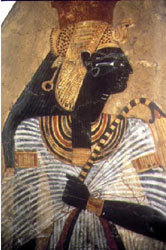
Then there's the entire Kushite Dynasty from Sudan who were black. This was a non-issue for Egypt. The biggest issue was if you worshipped their gods and respected their ways. If you did, then you were in. Alexander the Great was received like a hero because of this while the Persians were hated because of their disrespect for Egyptian culture.
3. Egypt even had what historians considered to be Asian rulers. The Hyksos invaders who ruled Egypt were from West Asia and some historians have posited that they were from the Indian subcontinent. (This has not been confirmed.)
Egypt was a melting pot with people from all over because of the lucrative trade routes. They were ruled by Greeks, Romans, Persians, Assyrians, Kushites, Hyksos, Libyans, etc. They had a blended culture.
So, it is interesting to me that this documentary chose a woman who was very clearly documented to NOT be black when Egypt has no shortage of Black figures to choose from. You'd think you'd want to tie yourself to the great legacies like Hatshepsut who made Egypt wealthy and stable over Cleopatra who lost Egypt its independence.
4. The one thing I CAN say for certain is that the actual Egyptians were NOT white. When I hear conspiracy theories that Ramses II was white from Scotland because he had red hair, it makes me so angry. They were not. Great things can and did come for non-white nations. Writing, language, government, medicine, etc ALL came from non-white nations. Egyptians referred to the Celts as Barbarians for a reason. Cleopatra, while she ruled Egypt, was NOT Egyptian. And that always gets forgotten. She hailed from a conquerer's line, not Egypt itself.
The thing about Egypt was they realistically depicted skin-color in Egyptian art. Maybe one day we'll find something of Cleopatra that will put this to rest. All we know is that her coinage shows her with distinctive European features, like a long, narrow, hooked nose. She has her hair in the Greek style.
341 notes
·
View notes
Photo

Figurine of the Kushite Pharaoh Taharqa and the Falcon God Hemen Taharqa (𓇿𓉔𓃭𓈎) “t3-h-rw-q”, a 25th dynasty pharaoh 𓉐𓉼 “pr-ˁ3” ‘Great House’ of the “Kushite Empire”, is offering wine while he is on his knees. He is wearing the shendit 𓈙𓈖𓆓𓅱𓏏𓋯 “šnḏw.t” loincloth, headband, double uraeus 𓅜𓏏𓆘 “3ḫ.t” offering two jars of nu 𓏌, (in front); Hemen (falcon). He brandishes a erect uraeus on his forehead 𓏅𓈖𓏏𓂉 “ḫnt” skullcap. In Egyptian mythology, Hemen 𓎛𓏠𓈖𓁜 “ḥmn” was a falcon–god, worshipped 𓇼𓄿𓀃 “dw3” in Hefat, who was depicted during the Old Kingdom as slaying hippopotami 𓂧𓃀𓃯𓏪 “dbw” and other symbolic forces of chaos. Dimensions: Height: 19.7cm; Length: 26cm; Width: 10.3cm Material and technique Material: wood (wooden base), bronze (Taharqa), chloritite (Hemen) Secondary material: silver (wooden base veneer), gold (Hemen) 📸 @museelouvre 𓋹𓎬𓋹𓎬𓋹𓎬𓋹𓎬𓋹𓎬𓋹𓎬𓋹𓎬𓋹𓎬𓋹𓎬𓋹𓎬𓋹𓎬𓋹𓎬𓋹𓎬𓋹𓎬𓋹𓎬𓋹𓎬 @egyptologylessons 𓋹𓊽𓋴𓆖𓎛𓇳𓎛 © 𓊁𓊁𓊁𓊁𓊁𓊁𓊁𓊁𓊁𓊁𓊁𓊁𓊁𓊁𓊁𓊁𓊁 #Ancientegypt #ägypten #egyptology #egypte #egitto #埃及 #مصر #egipto #이집트 #taharqa #hemen #pharaoh #statuette #falcon #guilded #louvremuseum (at Louvre Museum Paris) https://www.instagram.com/p/CnzV1Wbu0l5/?igshid=NGJjMDIxMWI=
#ancientegypt#ägypten#egyptology#egypte#egitto#埃及#مصر#egipto#이집트#taharqa#hemen#pharaoh#statuette#falcon#guilded#louvremuseum
44 notes
·
View notes
Photo
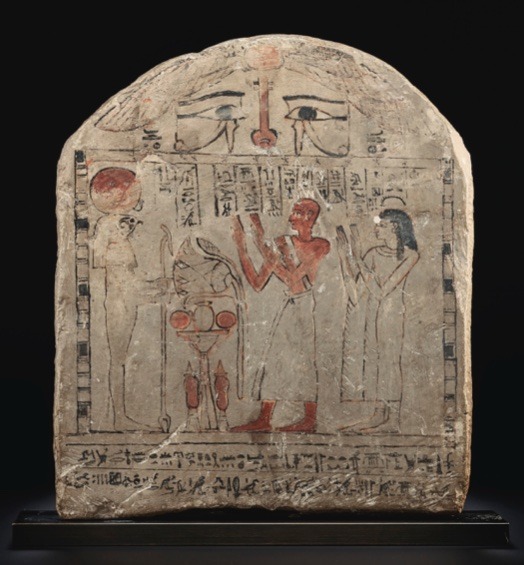
AN EGYPTIAN PAINTED LIMESTONE ROUND-TOP STELE FOR NES-PA-KA-SHUTY AND HIS MOTHER
THIRD INTERMEDIATE PERIOD, 25TH DYNASTY, 747-656 B.C.
12 9/16 in. (31.9 cm.) high.
The third prophet of Horus, Nes-pa-ka-shuty, stands in front of his mother with arms raised in adoration before a standing mummiform figure of Re-Harakhty. The lunette is centered on a nefer sign flanked by wadjet-eyes beneath a winged sun disk. Directionally oriented hieroglyphs identify each eye as “the Behdetite,” referring to Horus of Behdet. A table of offerings separates the supplicants from the god, piled high with a lotus resting atop a spouted vessel flanked by two bread loaves. On either side of the table are 2 wine vessels of typical Dynasty 25 form, sealed with conical lids, sit atop their own smaller stands. Despite the appearance of equal height, the sun-disk atop the head of Re-Horakhty reaches well above the top of Nes-pa-ka-shuty’s head or the funerary cone of his mother, who is dressed in a fringed garment of Kushite style. The reading of the mother’s name is uncertain (possibly to be read as Djebau(?)-ruty, but men and women with name elements such as Ruru or Ruty are well known from Abydos (see G. Vittmann, Priester und Beamte im Theben der Spätzeit, p. 49, n. 3). The bottom of the stela is dominated by two lines of inscription providing a typical offering formula naming Nes-pa-ka-shuty, his father Hor, and repeating the name and title of his mother.
#AN EGYPTIAN PAINTED LIMESTONE ROUND-TOP STELE FOR NES-PA-KA-SHUTY AND HIS MOTHER#THIRD INTERMEDIATE PERIOD 25TH DYNASTY 747-656 B.C.#archeology#archeolgst#ancient artifacts#history#history news#ancient history#ancient culture#ancient civilizations#ancient egypt#egyptian history#egyptian hieroglyphs
36 notes
·
View notes
Text
Pharaoh Taharqa happens to be another case of the early intersections of Jewish and Black history:
Ironically posterity would make Taharqa one of many cases of a Pharaoh whose reign wound up caught up in the discussions of Biblical historicity, in the proof of the existence of King Hezekiah of Judah/Yehudah/Yahud, fighting against both Sennacherib, who besieged Judah and helping to relieve the Israelite Kingdom, and then getting driven back into Kush by Sennecharib's successor as Emperor of Assyria, Esarhaddon.
Taharqa would have seen this as one of many battles and campaigns in a long career that brought the Kushite dynasty to its furthest reaches, Hezekiah and his Edomite counterpart as tribute-paying subordinates to him after he liberated them, and his career as predominantly directed against Assyria much as the most powerful Pharaohs fought the Hittites and the Mitanni.
Taharqa also makes the same point that would recur in other points, that rulers of Africa did have the power to push into Asia and Europe where geography permitted. It was not just the Amazigh or the Khemetic peoples who did this, where it was possible, the rulers of Black Africa did so and did so unapologetically like everyone else did.
Unfortunately geography meant that it was much harder to push up north against the weight of world states like Assyria, Rome, or the original Caliphates (not so much against the fragmented successors or the smaller state orders that were much more vulnerable).
#lightdancer comments on history#black history month#military history#kushite dynasty#pharaoh taharqa#jewish history#israelite history#kingdom of judah#assyrian history#'the assyrian came down like the wolf upon the fold'
1 note
·
View note
Text

ISLAM IN AFRICA.
The ancient Arabians are described as “Cushites” and “Semitic”, whom were described as “dark” and “brown” in complexion respectively.
According to the collaborative scholarship of Dr. Ben and Dr. George Simmonds, Muhammad’s grandparents originated in the Kingdom of Aksum modern day Ethiopia and were Kushites.
Muhammad’s grandfather frequently visited Aksum. Bilal, Muhammad’s “closest advisor" mother, was an Auximite and his father was an Arab and the same can be said for the Caliph Umar. (Jochannon 1991, p. 151) Bilal carried Muhammad’s lance, which was given to Muhammad by a companion, to whom it was gifted by the Ethiopian ruler of the kingdom of Axum.
You would now understand why the messenger of Allah may the peace and blessings of Allah ta'ala be upon him sent his companions to the Kingdom of Axum (Ethiopia) and not elsewhere on the Arabian peninsula. A similar journey he himself had undertaken when employed by his beloved wife Kadijah before his prophethood.
It is a commonly held belief that the 7th century Arabians attacked the African people and converted them to Islam by the sword. However, the works of Edward Wilmot Blyden known as “Father of Pan-Africanism” and of Dr. Cheikh Anta Diop show, Arabians introduced the people of the continent to Islam with no coercion.
“…What really took place, when the Arab met their Negro brethren in his own home, was a healthy amalgamation, and not an absorption or an undue repression.” (Blyden 1994, 14)
The primary reason for the success of Islam in black Africa, with no exception, consequently stems from the fact that it was propagated peacefully, Islam therefore is a religion of Africa and Africans.
An 18th century publication says, Islam was spread through Africa by African Muslims who established schools to teach its tenets to
their children, not by the sword.
The introduction of Islam into Kushite and Egyptian Africa liberated North Africa from oppressive Byzantine colonial occupation and rule.
Greek rule had become extremely repulsive in Egypt and it was gladly exchanged for the rule of the Muslins whom were called Saracens.
“The people of Egypt wanted the Muslims to enter the country in an effort to rid themselves of the Roman oppressors.” (Asante 2007, 213)
“The black Muslims came chiefly as traders. . ." and, “. . . gave frequent evidence of their respect for these black brethren nations." (Dubois 2001).
MUSLIM LIBERATION OF ISRAELITES IN PALESTINE.
The Hebrews Israelites under the colonial domination of the Byzantines in Palestine, were among the nations liberated by the 7th century Muslims.
After taking possession of Palestine from the Byzantines, Umayyad khalif Umar ibn Abdul Aziz (Omar II) opened Jerusalem to the black Israelites the decendants of Yakoob and gave them equal rights with the Christians. He himself helped to clean the Holy Temple of the filth and rubbish piled upon it by Christians to spite the Israelites. Israelites, here does not refer to the current white Ashkanazis Zionist of occupied Palestine.
“For a while, it must have seemed that the Moslems would overwhelm all of Christian Europe”.
“It is clear, however, that the conquest of Spain was undertaken upon the initiative of Tarik ibn Ziyad . . . a member of the Warfadjuma branch of the Nafza Berbers.” (Van Sertima 1993, 54)
Below, is an artistic rendition of General Tariq ibn Ziyad (670 CE – 720 CE).
THE PERSIAN OVERTHROW OF THE KUSHITE-ARABIAN KHALIFATE.
The Umayyad Dynasty from Muhammad’s tribe of Quraish (Quraysh), exercised exclusive rule over the Islamic World from 661 – 750 CE.
The exclusive rule of the Islamic empire by the Umayyads was short lived.
In a coup engineered by the Persian general Abu Muslim, in 750 CE, they were overthrown by the Abbasids. Abbasid culture would come to be dominated by the legacy of Persian civilization, and the capital of the Islamic empire was moved from Damascus to Baghdad, near the old Persian capital of Ctesiphon. (Latif 2019, p.3)
“Under the Umayyads, only those of full Arab parentage on both sides were admitted to the highest offices of the state. Under the ‘Abbasids, not only half-Arabs, but Persians and and former slaves rose at the caliphal court, where the favor of the ruler, more than noble descent, was the passport to power and prestige.” (Lewis 1995)
The remnant of the Umayyads, who grieved the decline of Arabian power, migrated westward and settled in Spain under the Fatimid Caliphate, or abode in Africa under the suzerainty of an Arab potentate, at a distance from the power of the Abbasids.
note-Israelites here refer to the descendants of prophet Yakoob who were all black and not the current European Ashkanazis jews who are currently occupying Palestinian lands.
10 notes
·
View notes
Text
I will be drinking this potion to travel back in time and hang out with the Kushite king Piye, who founded the 25th dynasty of Egypt. I will bring back a sports almanac so we can make some bets together.
3 notes
·
View notes
Text

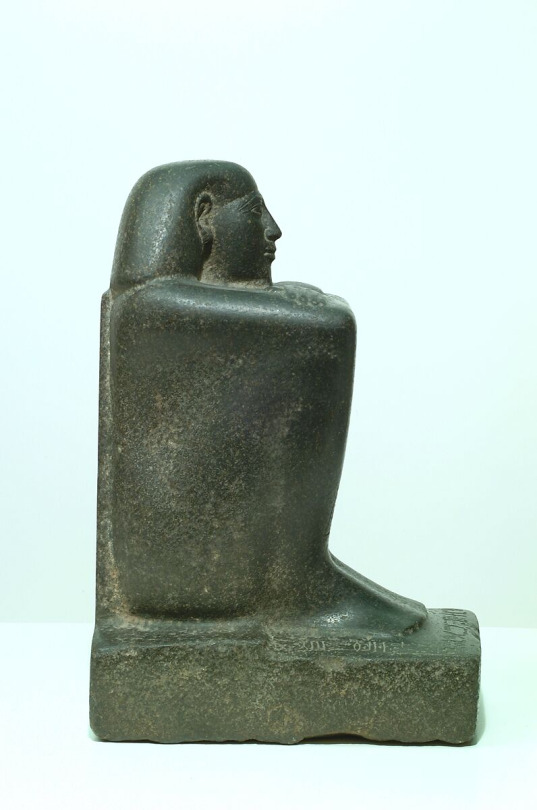

Block Statue of a Prophet of Montu and Scribe Djedkhonsuefankh, son of Khonsumes and Taat
Late Period, Kushite–Saite
690–610 B.C.
On view at The Met Fifth Avenue in Gallery 125
In the late 25th dynasty and early 26th Dynasty the austere beauty of the block statue form, here particularly enhanced by the hard gleam of dark surfaces, was greatly appreciated. The form puts a strong emphasis on the face and complements the often stern countenances favored at the time.
The front of the statue gives the names, titles and parentage of Djedkhonsuiuefankh, son of Khonsumes and Taat. Djedkhonsuiuefankh can be linked to a multigeneration illustrious family of priests at Thebes. On the top of the base is an appeal to the living, a request for offerings to those who would pass the statue where it was placed in Luxor Temple. On the back pillar is an inscribed formula known as the Saite formula.
Artwork Details
Title: Block Statue of a Prophet of Montu and Scribe Djedkhonsuefankh, son of Khonsumes and Taat
Period: Late Period, Kushite–Saite
Dynasty: Dynasty 25–26
Date: 690–610 B.C.
Geography: From Egypt; Made for Upper Egypt, Thebes, Luxor
Medium: Gabbro
Dimensions: h. 30.7 cm (12 1/16 in)
Credit Line: Rogers Fund, 1907
Accession Number: 07.228.27
Provenance: Purchased from M. Casira, Egypt, 1907.
Source: https://www.metmuseum.org/art/collection/search/547694
4 notes
·
View notes